Why You Should Never Declaw Your Cat: A Human Perspective
A Loving Guide for Future Scottish Fold Parents
At PurrfectlyFold, every Scottish Fold kitten is raised in our home with love, patience, and respect. Our goal isn’t just to find homes—we want to match our kittens with families who will cherish them just the way they are.
That’s why we need to talk about something important:
Declawing is not safe. It’s not humane. And it’s never the answer.
What Is Declawing, Really?
Many people think declawing is like trimming a cat’s nails. But the truth is much more serious.
Declawing (technically called an onychectomy) involves amputating the last bone of each toe—the part that holds the claw. It’s not a nail removal. It’s 10 separate amputations on a cat’s front paws.
👈 Imagine this happening to you:
If someone cut off every one of your fingertips at the last knuckle, how would that affect your life?
Typing, buttoning a shirt, picking up a glass—all would be painful or impossible. That’s what your cat feels after being declawed.
What Happens After Declawing?
Cats need their claws for balance, exercise, communication, and stress relief. Once those are taken away, problems often follow:
🐾 Chronic pain in the paws and joints
🚫 Litter box avoidance (scratching hurts, so they stop using it)
🧠 Anxiety, biting, and aggression
😿 Loss of confidence, especially in multi-pet households
🛑 Difficulty walking or jumping properly
Many cats suffer in silence for years after this surgery. What was meant to be a convenience for the owner becomes a lifetime of discomfort for the cat.
Scratching Is Normal — and Manageable
Scratching isn’t misbehavior. It’s how cats:
Stretch their spine
Keep claws healthy
Mark territory (with scent glands in their paws)
Release tension and stay emotionally balanced
Declawing removes more than claws—it takes away a vital part of their natural behavior.
Safe and Humane Alternatives to Declawing
Here’s how you can protect your furniture and love your kitten with all their parts intact:
✅ Scratching posts and pads
Place them near furniture or windows, and offer different materials (carpet, sisal, cardboard).
✅ Cat trees and climbing shelves
Enrich your space so your cat has areas to scratch, jump, and stretch.
✅ Nail trimming every few weeks
A quick snip of the sharp tips makes a big difference. (We can teach you how.)
✅ Soft nail caps like Soft Paws
These are gentle, non-toxic caps that go over the claws and last a few weeks.
✅ Furniture protectors and repellents
Double-sided tape or citrus-scented sprays work well as gentle deterrents.
Our Promise: No Declawing, Ever
At PurrfectlyFold, we do not allow our Scottish Fold kittens to be declawed.
We include this in our kitten agreement, because we believe anyone who adopts one of our babies is adopting a life—not just a look.
🐱 You are adopting a living being, not a couch protector.
Together, let’s raise cats with compassion, not convenience.
Want More Help?
We’re always here to support our kitten families—before and after adoption. If you’re unsure how to trim nails or redirect scratching, we’ll guide you. That’s part of being a responsible breeder and a forever support system.
Further Reading:
The Paw Project – Advocacy to end declawing
AVMA Policy on Declawing – American Veterinary Medical Association
End Cat declawing – The Humane World of Animals

